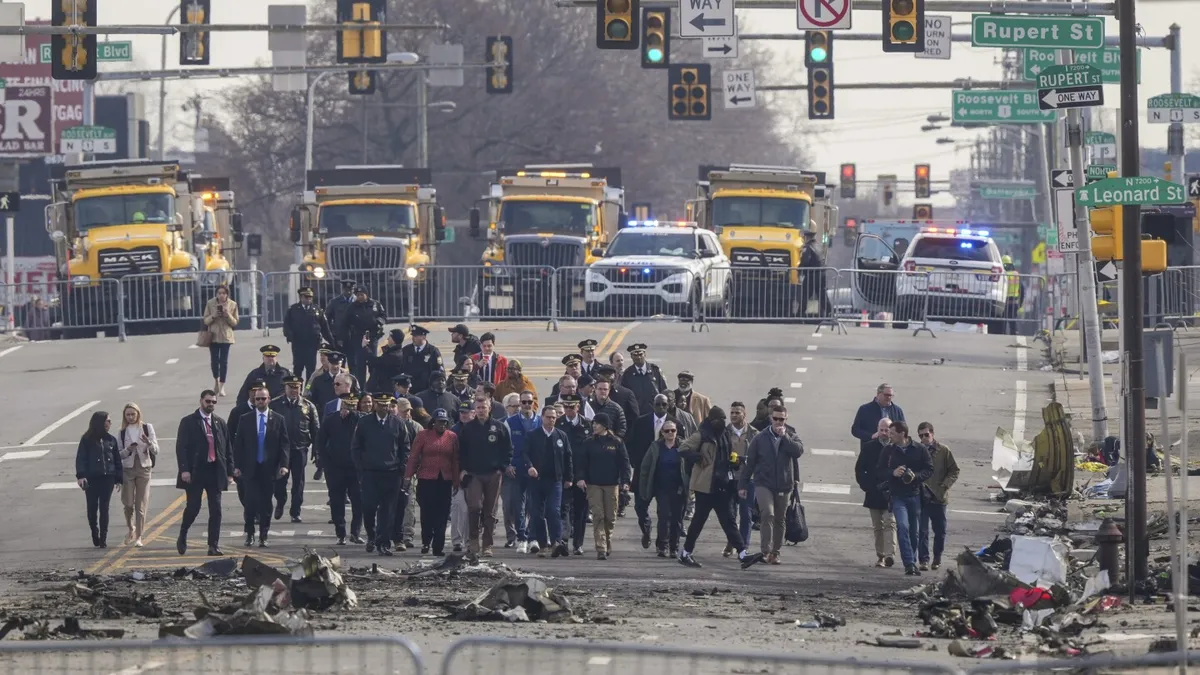
In a devastating incident that shocked the community, a medical transport plane crashed in a Philadelphia neighborhood on January 31, killing seven people. The National Transportation Safety Board (NTSB) has released a preliminary report indicating that the cockpit voice recorder on board was not operational at the time of the crash and had likely been malfunctioning for several years. This critical failure raises significant concerns regarding pilot communication and flight safety.
The unfortunate accident occurred shortly after takeoff from Northeast Philadelphia Airport, where the Learjet 55 plummeted into a residential and commercial area within just a minute of departure. The impact resulted in a massive fireball and ultimately claimed the lives of all six individuals on the aircraft, along with a seventh victim who was in a vehicle on the ground. Additionally, the crash left at least two dozen others injured, including a 10-year-old boy who was struck by debris while attempting to shield his sister.
Former NTSB Chairman Jim Hall expressed deep concern over the discovery that the cockpit voice recorder was non-functional. He emphasized the importance of such recordings in investigations, stating, “It’s a significant loss of important information that should have been there.” The report also confirmed that the crew did not make any distress calls to air traffic control, indicating that the emergency unfolded too rapidly for communication.
Among the passengers on the ill-fated flight was an 11-year-old girl, Valentina Guzmán Murillo, who had recently received medical treatment at the Shriners Children’s Philadelphia hospital. The plane was operated by Jet Rescue Air Ambulance, which identified the onboard team, including Dr. Raul Meza Arredondo, the captain Alan Montoya Perales, co-pilot Josue de Jesus Juarez Juarez, and paramedic Rodrigo Lopez Padilla, all hailing from Mexico.
The NTSB's preliminary findings revealed that the cockpit voice recorder was recovered from a depth of 8 feet (2.4 meters) underground, suffering extensive damage and exposure to liquids. Despite efforts to clean and repair the device, the agency found that the 30-minute tape did not contain any audio from the flight. This absence of data complicates the investigation but does not render it impossible. Former NTSB investigator Jeff Guzzetti noted that the agency could still ascertain a probable cause based on circumstantial evidence.
According to Rogelio Rodríguez Garduño, a professor of aviation law at the National Autonomous University of Mexico, Mexican regulations mandate that aircraft owners include cockpit voice and flight data recorders in their maintenance plans. The governmental authority responsible for aircraft registration is tasked with ensuring compliance with these regulations at least once a year. However, civil aviation authorities in Mexico have yet to respond to inquiries regarding Jet Rescue’s maintenance protocols.
Guzzetti, who previously investigated high-profile crashes, suggested that this incident may share similarities with cases of pilots experiencing spatial disorientation. This phenomenon can occur in low-visibility conditions, where pilots lose their sense of direction and fail to trust their instruments, leading to erratic maneuvers. The Learjet reportedly descended rapidly and executed turns similar to those seen in previous accidents, raising questions about pilot decision-making during the crisis.
In the wake of the crash, several victims on the ground have retained legal representation to pursue potential lawsuits, including a man who suffered severe burns when his SUV was engulfed in jet fuel. This tragic event has sparked renewed concerns about aviation safety, especially following another recent midair collision involving an American Airlines jet and an Army helicopter, marking one of the deadliest air disasters in recent U.S. history.
The NTSB continues its investigation into the Philadelphia plane crash, with many hoping that the findings will lead to improved safety measures in aviation operations.